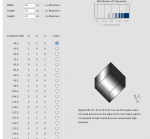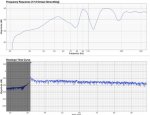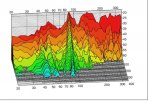The 38% location was a suggestion made by studio designer (who I believe we can now refer to as "world renowned" seeing as he is designing studios in Europe as well as the States) Wes Lachot - who has made it quite clear that this was never intended to be viewed as a rule.
Doggone Rod, the first time I read about the 38% "rule", I would have sworn the person who posted it said it was from Phillip Newell. In fact, I could have sworn it was Ethan who said it, but I could be wrong. Not that it matters.
However, I DO have a problem with the whole "sweet spot" thing when it comes to laying out a room from the get-go where SOFFITS are to be employed. In fact, this is precisely where I get frustrated about the 38% thing. The problem I experience, is with a CR WIDTH/LENGTH ratio, the centerline plane of a 60 degree monitoring geometry vs the placement of the monitor within the geometry of a soffit, the distance of the monitor face from the "sweet spot", the area between soffits, and the vertical angle of the soffit face. All of which can be manipulated to achieve any number of arbitrary "sweet spots" along the long axis room centerling. Its when juxtapositioned against this so called starting point(amongst other "school of thought" issues) that really frustrates me, as there is NOTHING that I've ever read that gives a person such as me the scientific rational behind all these variables that verifys any given layout is actually putting the "sweet spot" at the correct point along this long axis room centerline and why it should be that point. The point being, with soffits, you can start at a 38% point, do the layout, and manipulate everything to hold that point, but then it affects other so called "points of view", and once you've established the soffit/monitor geometry...YOU CAN'T CHANGE IT AFTER THE FACT!!

And I CAN illustrate this. But not at this time.
I come across this EVERY single time I lay out the front end of a CR...to the point I FINALLY got so mad over at Johns site on a thread regarding this whole soffit thing that I point blank told a long standing member(STUART), there are NO STINKING ABSOLUTES!!! And to prove my point that Stuarts statement was incorrect, I used one of Wes Lachots designs to do so. Here is the what I posted, which was in regard to the area of the soffit face around the monitor, among other things(on another thread Stuart suggested the area around a monitor on a soffit face MUST be at least TWICE the width of the monitor...which when you view this design from Wes...laughs in Stuarts face.

)
Which, to my surprise...Wes even joined Johns site, and commented on that thread that I was ABSOLUTELY correct...there are NO ABSOLUTES!! Which tells me something, but conversely, leaves me wondering about lots of other things that have become so called "schools of thought", especially after seeing many of Wes and other designers projects that illustrate Wes is right. There are NO absolutes...other than maybe what Francis Manzella told me when I asked him what is it that "certifies" any given design meets the "acoustical parameters" set in the designer/client contract..to which he replied...THE CHECK.



Even the "acoustical parameters" are a thorn in my side, as "standards" such as the EBU seem to be used like a client/designer financial and acoustical arbitration checklist...ie...Client: "well, I can't afford to move this wall so forget meeting ISO### or EBU###..I'll let you slide on that one..besides, no one will know but me and you(designer)

Sorry for the fantasy Rod, but I think you get my point. Afterall, Manifold's geometry goes against everything I ever read about Studios. Even a few comments on Michaels Manifold thread at gearslutz reflects my view that nothing is sacred when it comes to clients wishes.

Even if its a studio looking like a circus(see Newells book


)
But back to the "sweet spot" issue. I would like to illustrate my point, but will do so on another thread so I don't hijack this one any further. I will post some Sketchups and maybe you can help eliminate a few of my questions. I mean...I fight this battle every time I work on a CR/Soffit design. Hopefully you can clarify some issues for me. Reason is, I have some Sketchup tools for sketchup newbees, that will help them with their layouts...IF I can back up my reasoning and perspective for the way the tools work, with PRO logic.

Once I have that, then I will post these Sketchup studio layout tools here.
Anyway, carry on gents.

fitZ












 )
)

 Even the "acoustical parameters" are a thorn in my side, as "standards" such as the EBU seem to be used like a client/designer financial and acoustical arbitration checklist...ie...Client: "well, I can't afford to move this wall so forget meeting ISO### or EBU###..I'll let you slide on that one..besides, no one will know but me and you(designer)
Even the "acoustical parameters" are a thorn in my side, as "standards" such as the EBU seem to be used like a client/designer financial and acoustical arbitration checklist...ie...Client: "well, I can't afford to move this wall so forget meeting ISO### or EBU###..I'll let you slide on that one..besides, no one will know but me and you(designer)
 Even if its a studio looking like a circus(see Newells book
Even if its a studio looking like a circus(see Newells book